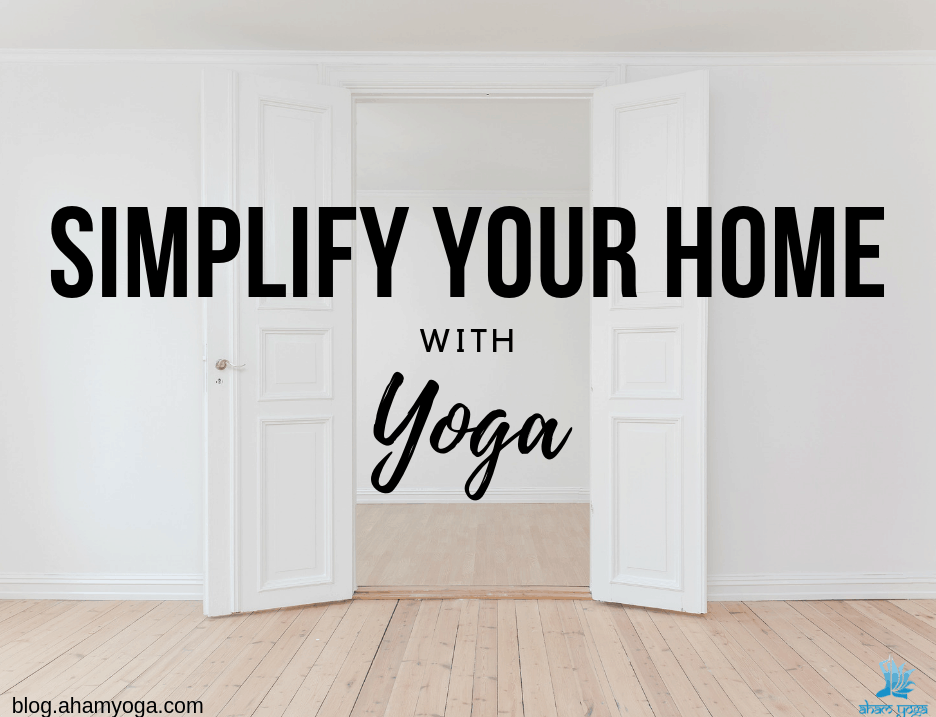Aside from the physical practice of yoga, you’ll discover a rich bank of practical wisdom that can be used for everyday living to enrich our lives by simplifying and giving us more clarity and peace. We have what we call the yamas and niyamas in yoga. Essentially, think of these as a roadmap for how to live a better life. The great news is that you actually need to do less, not more. For this reason, I am excited to share with you ways to declutter your home with yoga.
I know you’re probably wondering, how? What could the physical act of yoga have to do with your home and clutter? If you look closely, there’s an intrinsic connection between our inner and outer space. I know it sounds very Marie Kondo like, but this has existed for centuries long before the trendy Netflix show. Ancient yogis discovered ways to live in which we not only simplified our lives and needs, but more importantly we advanced our lives spiritually. Everything we do under the umbrella of yoga is essentially aiming to take us higher on the path of spiritual advancement.
There are 2 main concepts we need to understand before diving deeper: Asteya & Aparigraha. Think of these as two sides of the same coin. They fall under the umbrella of what’s called yamas in yoga. Yamas are guidelines or suggestions on how to be with ourselves and others. Sometimes, yamas are called restraints. I don’t like referring to it in that way as it sounds restrictive and nothing about yoga is meant to be restrictive. Yamas are simply suggestions. Now let’s get to work!
The Principle of Non-Stealing
The principle of non-stealing is called Asteya. How often are you out in public or logged into social media and see something that belongs to someone else and wished you had it too? Whether it is was a new car, a big house, a fancy vacation, a thinner body, a perfect relationship, etc…it happens to all of us. Even when we are focused on our yoga mats, we often find ourselves wishing for someone else’s yoga abilities. It’s just human nature to see what’s lacking in ourselves and assume others who have more of it, better of it, etc. Ancient yogis were not referring to physical stealing, they addressed our mind and how we mentally seek things that don’t belong to us.

How to practice Non-stealing?
- The first step is to begin consciously recognizing when your mind starts coveting something that doesn’t belong to you.
- Instead of instantly feeling envy, feel happy for them. Replace negative emotions of insecurity or jealousy with a more positive one. Do your best to feel joy for their success, gratitude that there is enough abundance for all, and acknowledge the hard work they must have put in to be successful. This will train your brain to look at things with a new, more positive perspective instead of being stuck in a negative loop.
- The most important step is to then feel and show gratitude for what you have, both material and non-material things.
The Principle of Not-Hoarding
In yoga philosophy, we call this Aparigraha, which literally addresses our need to hoard and possess material things. Ancient yogis lived with very little material things. They in-fact saw material possessions as an impediment to spiritual advancement. Often, they had little or no possessions at all. They wandered in search of knowledge and enlightenment and lived off the kindness of strangers. While this is not practical for us in our modern day living, we can definitely use this as a guideline to simplify our everyday lives. Nowadays, with social media and online shopping so conveniently available, we’re bombarded with the need to get more. more, more, of material things.
What Patanjali is showing us is that when we have a lot of material possessions, it leaves us feeling fearful that someone will take them away from us. We then have to worry about its upkeep and paying for it. This robs us of being in the present moment and forces us to live in the past or fear for the future. We must understand life only exists in the present moment. Let’s take a look at some practical ways to transition to a non-hoarding lifestyle.

Questions to ask yourself…
- Is it a WANT or a NEED?
- Is there something else that already exists in your home or life that can fulfill this purpose?
- If you gave it away, would it impact your life negatively?
- Is there a reason you’re holding on to it?
- Do the things you have bring you joy or worry?
Steps to Non-hoarding
- Start taking baby steps in evaluating your possessions. For example, begin with just one drawer in your bedroom or kitchen.
- Go through it, remove things that are old, broken, or no longer of use. Donate whatever you think will add value to other people’s lives and get rid of everything else.
- Set an intention to pause and reflect before you decide to bring something into your home. Is it going to add value and enrich your being? How will it end up in the world after you’re done with it?
- Is it an urgent need or can it wait a little longer?
- Consider whether someone you know already has an extra one or something similar. Ask in Facebook groups or friends circles first before buying.
In today’s world, this is one of the most difficult concepts to grasp and hold on to as social media and day-to-day life encourages the more, more, more mentality. We hope these simple steps give you a great starting point or at least encourage you to begin considering it may be something to think about. Comment below the steps you’ve taken to simplify your home!

